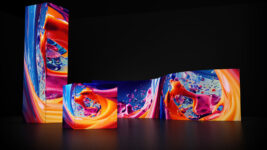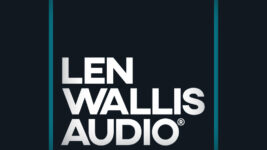ROAD TEST
22 Jul 2024
Road Test: SSL The Bus+
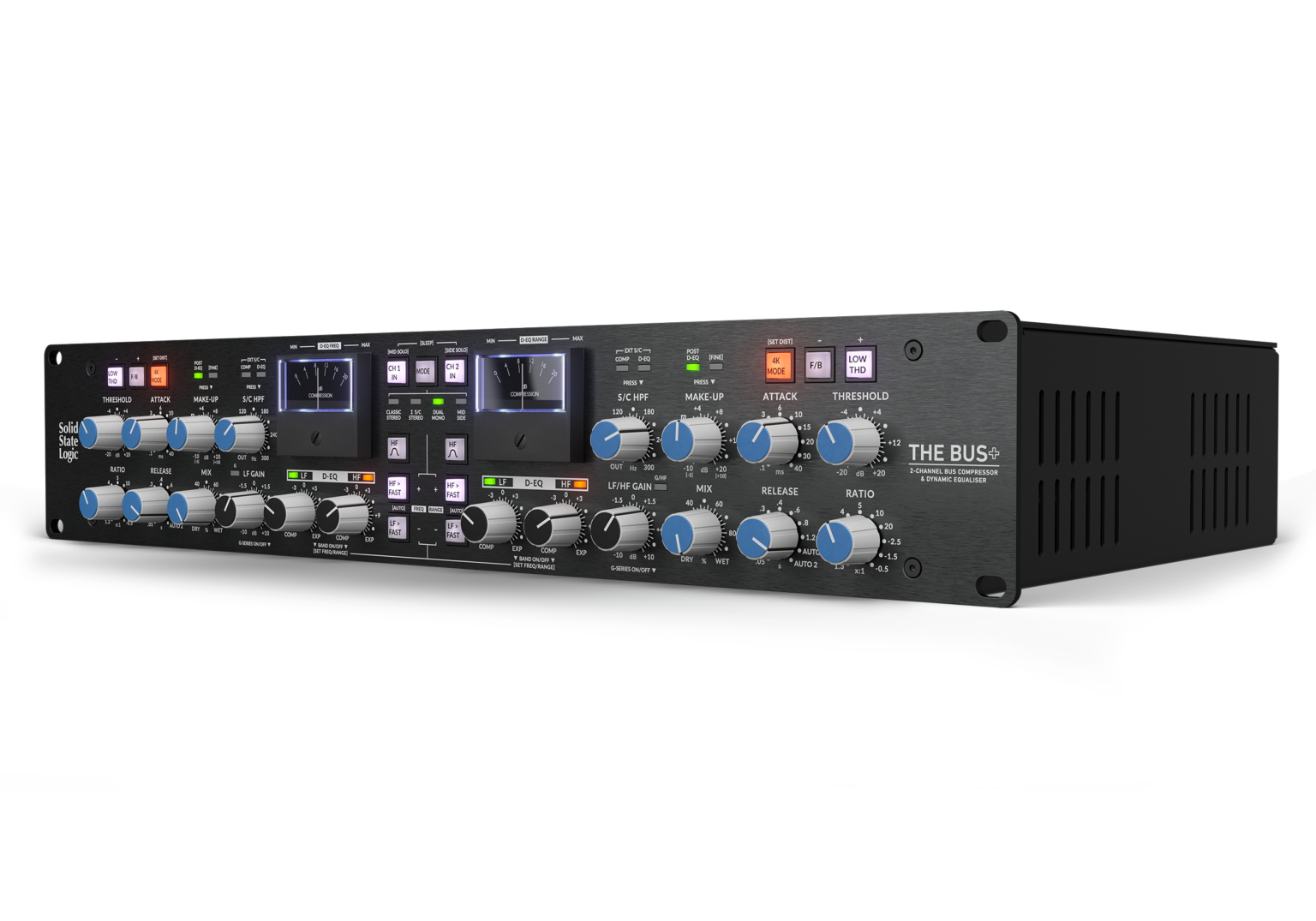
Subscribe to CX E-News
If there’s one feature of an SSL console that’s iconic beyond all others, it’s surely the legendary mix bus compressor. This unassuming analogue processor has been strapped across more mixes than any other compressor in history. It’s been mimicked by countless analogue third parties and reskinned in plug-in form by every man and his digital dog. SSL recently released its own reincarnation of the legend – The Bus+ – which is fast shaping up as one of the greatest analogue compressors ever brought to market.
Solid State Logic is so well known in the annals of pro audio that it’s hard to know where to begin to define the company without sounding like the pages of one of its own glossy brochures. And so embedded is the brand in the wider music culture that no interview with a famous rock star seems complete without them seated at helm of an SSL console – they are quite literally the general public’s visual definition of the very notion of a recording studio.
As a company, SSL has moved with the times far more deftly than anyone could have anticipated, particularly this century, becoming far less reliant on the sale of monster analogue consoles and flexible enough to survive the wholesale switch to a primarily digital workflow.
The Bus+ is one of SSL’s more recent offerings, and one of its best (and most complex) yet.
In a nutshell, The Bus+ is a fully analogue, digitally controlled stereo VCA compressor based squarely on the circuitry of the famed original. However, unlike its iconic console- bound equivalent, The Bus+ is one of, if not the most, versatile and complex outboard compressors ever encountered by humans. It’s a compressor with a uniquely vast, feature- rich set of dynamic tone-shaping tools that can modify incoming signals in extraordinarily diverse ways. Indeed, so complex and varied in scope is this compressor that even an overview of what it has to offer is well beyond the breadth of this review. It frankly makes most other compressors on the market look decidedly backward, and in the hands of more experienced engineers, The Bus+ will no doubt provide years of highly creative and satisfying sonic outcomes. To that, I would also add that almost no-one will ever quite plumb the depths of this unit’s capacity or control parameters.
To cover what this awesome compressor is truly capable of could fill the pages of this magazine almost entirely.
Simply put, The Bus+ is a stereo compressor that features independent left- and right-side stepped Threshold, Ratio, Attack and Release controls, the latter two of which now offer 11 settings (the Release control, in particular, now featuring not one, but two, dual-stage Auto release modes). Alongside these controls are a Make-Up Gain knob that, when pressed, places the compressor after (i.e., post) the Dynamic EQ stage…
Wait, what? Dynamic EQ?
That’s correct, The Bus+ has an analogue Dynamic EQ section that’s a mind-bendingly influential signal processor unto itself, which we’ll discuss further in a moment. The Make-Up Gain meanwhile can also be put into a ‘fine’ mode, which provides adjustment in half-dB steps. All of these stepped pots, I might add, are managed by a microcontroller, which makes them effectively immune to inaccuracy – precise indeed and fantastic for mastering.
And as you can see, already we’re well beyond the feature set of most classic analogue compressors.
But The Bus+ goes way beyond this, adding a truly breathtaking array of additional control that can be used to produce all manner of dynamically diverse compression outcomes. So please, while you can, take a deep breath…
Here We Go!
To kick things off there’s a Mix control on both left and right channels (that blends the compressed and uncompressed signals – but not the Dynamic EQ stage). There are also independent 12dB per-octave Sidechain high-pass filters for left and right on 31-position stepped pots, ranging from off to 300Hz (in 10Hz increments), which can also be deployed in a complex combination of External and Internal sidechaining of the compressor and Dynamic EQ (that’s really a topic for the full magazine-length review!)
Fundamentally, there are four operational control modes for the compressor, selected via the central Mode switch. These are Stereo, Dual Mono, Mid-Side (that even allows you to solo M or S separately!) and a fourth labelled ∑ S/C Stereo (which sums the left and right side-chain signals together to make the compressor more sensitive to mono content in a stereo mix). The Mode switch toggles you through the four options, but cleverly – and like almost every other switch on the Bus+ – it also has a secondary function, allowing you to toggle back and forth between two adjacent modes for A/B’ing purposes. The channel arming (in/ out) controls either side of the Mode switch also have multiple functions, including the soloing of mid and side, behaving as clipping meters, as well as putting the compressor to ‘sleep’ – I kid you not.
On the top left-hand (and right-hand) sides of the compressor are three soft-switches, and this is where things start to get really interesting. The first of these is a ‘Low THD’ switch that significantly reduces the low-frequency distortion inherent in a ‘classic’ SSL compressor. This arguably resolves one of the least popular aspects of earlier SSL bus compressors that tended to grab hard onto low-frequency content, reducing overall bass perception while simultaneously adding distortion to the low-end. It’s also why many engineers have barely ‘tickled the mix’ with an SSL Bus compressor – for fear of the compressor clobbering the incoming signal. But a modern SSL bus compressor like the Bus+ already produces far less harmonic distortion down low, and with the Low THD switch engaged, the Bus+ enters new super-clean compression territory uncharacteristic of an SSL.
Beside the ‘Low THD’ switch is a Feedback (F/B) switch which again changes the compressor from a famously grabby, jumpy (and some might say over-reactive) feed-forward design into a slower, more relaxed feedback design, that’s quite uncharacteristic of the ‘classic’ SSL sound. It’s cleaner, more transparent, and far less overt, making the compressor far better suited to slow and subtle acoustic music, as an example.
The third switch in this group has the opposite effect of the other two. The ‘4K Mode’ switch unbalances the compressor’s VCA, a la SSL’s 4000-Series console bus compressor of yore and adds harmonic distortion (though not merely in and ‘on’ or ‘off’ capacity). There are nine levels of harmonic distortion content on offer, accessed by clicking and holding the 4K Mode button, which turns the other two adjacent soft-switches into up/down selectors. As you increase the distortion levels for more grit, crunch and mayhem, the 4K switch changes colour, from white, through yellow and orange, to angry red. This sounds fantastic, depending on your requirements, and makes the compressor even more versatile.
There’s also a two-band Dynamic EQ (D-EQ) section for left and right, lurking below the gain reduction meters, which features adjustable expansion and compression that can be placed before or after the compressor. This is a game-changer for SSL and bus compressors generally. Dynamic EQ control adds further nuance and complexity to the way this compressor glues an audio signal together.
SSL designers clearly weren’t content to simply add static high and low compensatory shelving EQs either. By adding dynamic EQ that can be placed before or after the compressor stage, countless new control options open up, giving the compressor a quasi-multi-band sidechain, expander features for tops and bottoms, and a thousand variations besides.
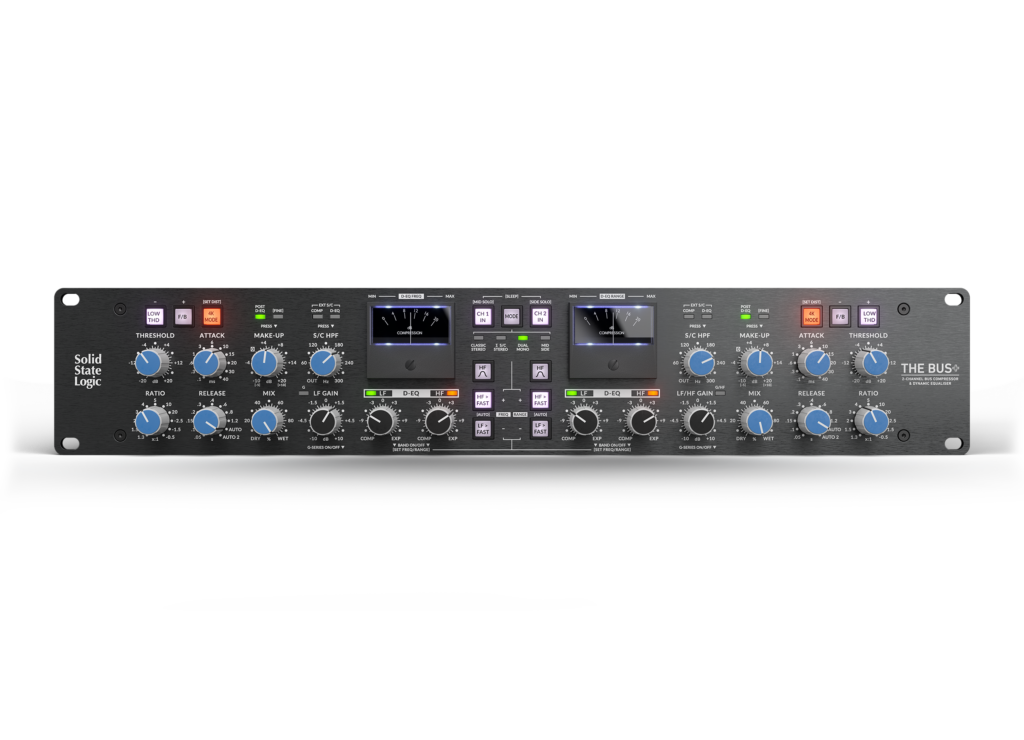
But the feature doesn’t stop there. Everything about the D-EQ is also adjustable. The time constants of the expander/compressor circuit can be altered from slow to fast (and even auto release), the high shelves can switch to bell curves, and the activity of the circuit even has metering via the LED lights above the LF/ HF knobs that change colour with intensity of effort.
You can even choose where on the frequency spectrum you want the LF and HF shelving controls to focus, per side, and for this there are – somewhat incredibly – 16 different frequency points to choose from. LF is adjustable from 20Hz up to 170Hz, and the HF from 2kHz up to 17kHz, and when the ‘HF Bell’ is in play, the peak is adjustable from 700Hz up to 16kHz.
How all this is achieved is even more incredible. Holding down the LF or HF knobs on either left or right (independently) turns the gain reduction meter backlights into a flashing disco, the left needle of which now points to where on the frequency spectrum your filter is aimed. But you’ll have to use your imagination to work out where you are on the spectrum – there are no frequency markings on the meter. Likewise, the D-EQ also allows you to restrict the range of both compression and expansion for each band, effectively adding another limiter to the equation – incredible stuff. Here too, the adjustment is made via the gain reduction meter disco, only this time the right- hand meter indicates the range adjustment, and the markings already on the meters double as range indicators. And wait for it: there are 23 different ranges values to choose from; the first 17 in 0.5dB steps, the last six in 1dB steps.
To digress for a moment, I must note that – somewhat confusingly for many I’d wager – the controls on the front faceplate of the compressor are mirrored – i.e., the far-left Threshold control for instance, has its right-hand equivalent to the far right – the controls effectively appearing in reverse order on the right side of the unit.
But there’s one exception. When you look closely you discover that there’s a Low- Frequency Gain control on the left that differs from its right-hand equivalent. On the left, this control boosts or cuts the LF by up to 10dB, adding shelving adjustment in conjunction with the LF compressor/expander control. So if, let’s say, you’re using the compressor/expander control to compress the lows significantly, you can then boost it again to compensate. But its equivalent right-hand control (labelled LF/ HF Gain) only controls low frequencies in Mid/ Side or Dual Mono modes. In the other two, this control becomes a high-frequency static boost or cut. Embedded in these controls (activated via a control knob press) are also SSL ‘G-Series’ filter options that change the shape of the filter’s curve.
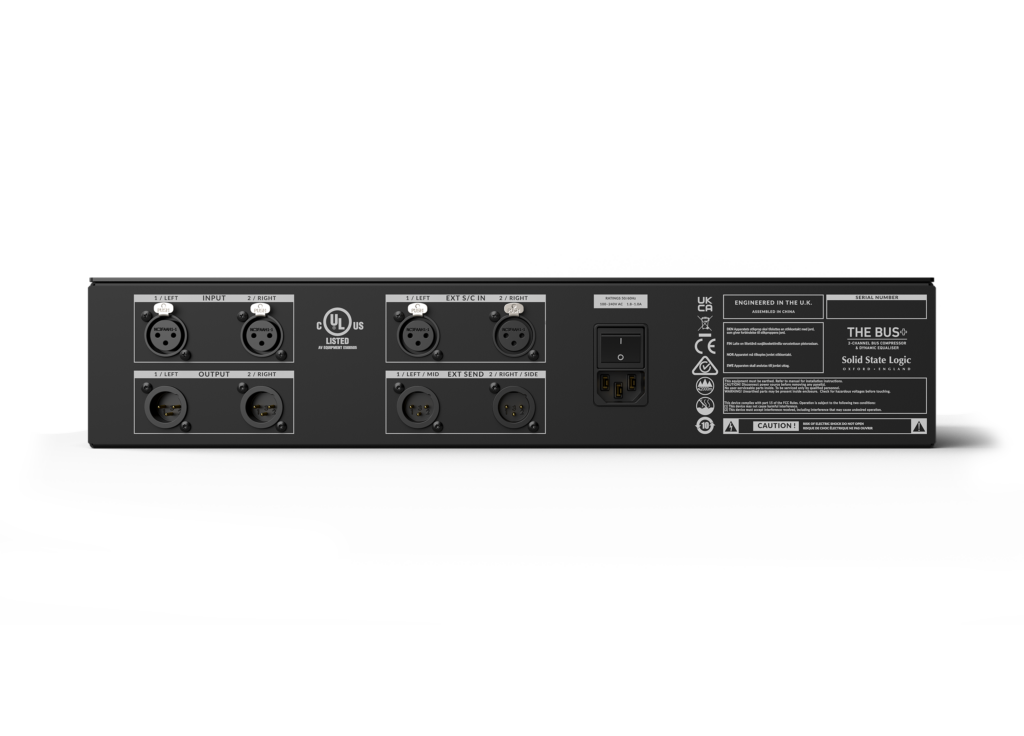
The Bus+ Gets An A+
I could go on and on here about dozens of other features The Bus+ has to offer – from the various Settings options, the calibration and sleep modes, the multiple Mix modes etc – but I’m out of room, and I’m concerned that you, the reader, might have had a gutful of all of this by now.
Suffice it to say The Bus+ is an incredible compressor, more versatile than any other compressor I’ve ever heard – certainly in the analogue domain. It wipes the floor with many others regardless of their value, and like almost no other compressor, The Bus+ doesn’t sound like anything… in fact, more accurately, it sounds like everything! It’s complex, sure, but if you can cope with the substantial learning curve of this device, the reward for your efforts is vast.
Product Info: solidstatelogic.com
Distributor Australia: www.ambertech.com.au
Distributor New Zealand: amber.co.nz
Subscribe
Published monthly since 1991, our famous AV industry magazine is free for download or pay for print. Subscribers also receive CX News, our free weekly email with the latest industry news and jobs.



